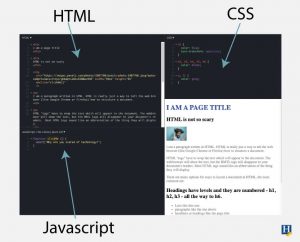
Tips for Using the Internet in Your Homeschool: Part 1
January 30, 2021Meg Phillips, award winning technology developer homeschooling since 2020.
Making the most of internet technology in your homeschool starts with a basic understanding of the underlying systems and institutions. We all use technology every day in so many ways. However, for many of us, that technology is a mystifying black box that makes life a little more convenient.
The goal of this article is to demystify internet technology with 10 beginner truths about the internet every person should know.
Proceed With Caution
There are many wonderful resources, fun applications, social opportunities, and useful technologies available to us free of cost or at a minimal cost.
Proceed with caution remembering that “free” is never “free.” Technology is expensive to build and particularly expensive to update, maintain, and support. This is especially concerning in homeschools with children involved.
“Free” Is Never Really Free
Useful technology that costs nothing or very little to use has been funded in some fashion. Cost-less technology is often paid for by three mechanisms:
- Non-profit
- Venture capital
- Sweat equity
Technology Funding Models May Have Concerns For Homeschoolers
- Non-profit funded tech is usually mission-driven and may have a mission that does not align with your family values.
- Venture funded tech often has a hidden profit center often associated with gathering data and profiting from that data via advertising opportunities or directly selling data to other institutions.
- Sweat equity tech often loses traction and later becomes badly maintained or abandoned.
Privacy Is Important
Privacy is important. When we use cost-less technology we often unknowingly make decisions for our children that can and possibly will affect them later in life.
Many countries and large institutions use the resulting datasets to make policies that affect us in our everyday lives. Be very careful “checking the box” to the terms of use or any privacy statement. Read the fine print.
The Internet Was Invented To Share Information
The best tools are the tools that are fit to purpose. The internet is – at its very core – a tool for sharing information. Reliably keeping information private which is published on a tool built to share information is quite difficult.
The simplest answer for whether to use any resource or application is, “Do I want the information gathered during my use of this application made public?”. If you are inputting private information into a connected application, there is always a risk of that information being compromised. Weigh the risk-benefit.
The Internet Is A Bunch Of Little Documents
The internet is just a giant collection of documents stored in a file structure on a computer in some other location. Surely that is an oversimplification, but that is the core mechanism of the internet.
The apps we use every day on the internet such as Facebook, Google, and Wikipedia are really just a whole bunch of data written into a document and then stored in an organized fashion.
Internet applications are built with three types of files:
- HTML: provides the core content and structure to the document
- Javascript: provides interaction with the user
- CSS: provides the style, color, and layout to a document
HTML Is Like 4th Grade Grammar
Most students learn basic document structure starting around 3rd or 4th grade. The internet is written in a language called HTML, Hyper-Text-Markup-Language. If you can identify a headline, a list, and a paragraph in a document then you can write HTML.
In fact, teaching writing the other way around – HTML first – helps students appreciate good information organization and clarity of thought as they learn to write. This is a way of enforcing better-written communication skills.
Check out this fun little illustration of a webpage built with HTML, CSS, and Javascript. To create this illustration I used an interactive learning tool called JS Fiddle. What you see is a webpage in the bottom quadrant and the three files that work together to publish the document in the other three. JS Fiddle is a fun and safe tool for experimenting and learning to use internet technology.

Content Management Systems (CMS)
As internet technology has evolved, content management systems have emerged as the most common way to publish content on the internet. A content management system is a piece of technology that allows a person to publish on the internet without writing HTML, CSS, or Javascript.
More than 38% of websites and many of the web applications you use are all built with the same content management system – WordPress. WordPress is an open-source technology that is free for any person to use. It is a good idea to learn WordPress in your homeschool environment.
The Internet Has Rules
Just like most other institutions and shared tools, the internet comes with rules, regulations, standards, and best practices. There is a governing body for the internet called W3C that publishes the rules of the internet. Here is a link to learn more: https://www.w3.org/Consortium/
Technology Is Perfect For Homeschooling
Never in history has so much great learning material been available at our fingertips. Learning to identify high quality and safe learning opportunities on the internet adds so much value to the homeschooling experience.

More About The Author
Meg Phillips is a mom, marketer, and web developer. Before having children, Meg worked in apparel product development and was proudly part of the team to launch Soma by Chico’s. Since becoming a mom, Meg continues to work as a product developer focused on software engineering award-winning technology solutions including the 2020 Call For Code Global Top 5 Winning education solution, School List It. Meg is the founder and CEO of MSP-Media, the group responsible for other award-winning platforms including Hyperlocal News and Charter Boat Bookings. You can find Meg on Making WordPress Slack, Twitter, and Youtube with the handle @MegPhillips91.
Latest Posts

While nearly every college and university today is eager to accept homeschooled students into their institutions, homeschooling families need to understand that their student’s application…
Read more >
Guest Post by Gabriel Morse For several years, I sat for long hours every day behind one of those battleship gray desks in a windowless, dull, gray office. The pay was enough to take care…
Read more >
This post is sponsored by Little Monsters Universe. I'm Tina Salmanowitz, an advocate for homeschooling and science education. With over a decade of experience as a science educator (in class…
Read more >

